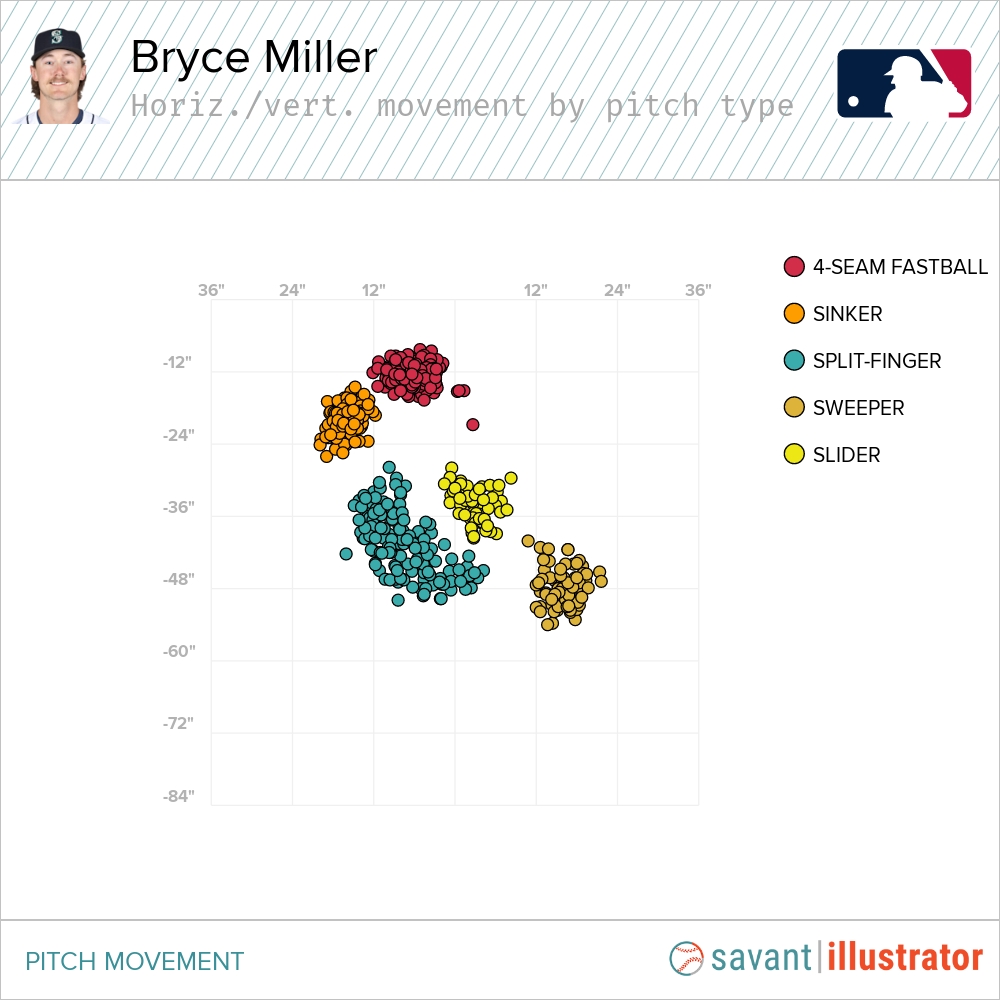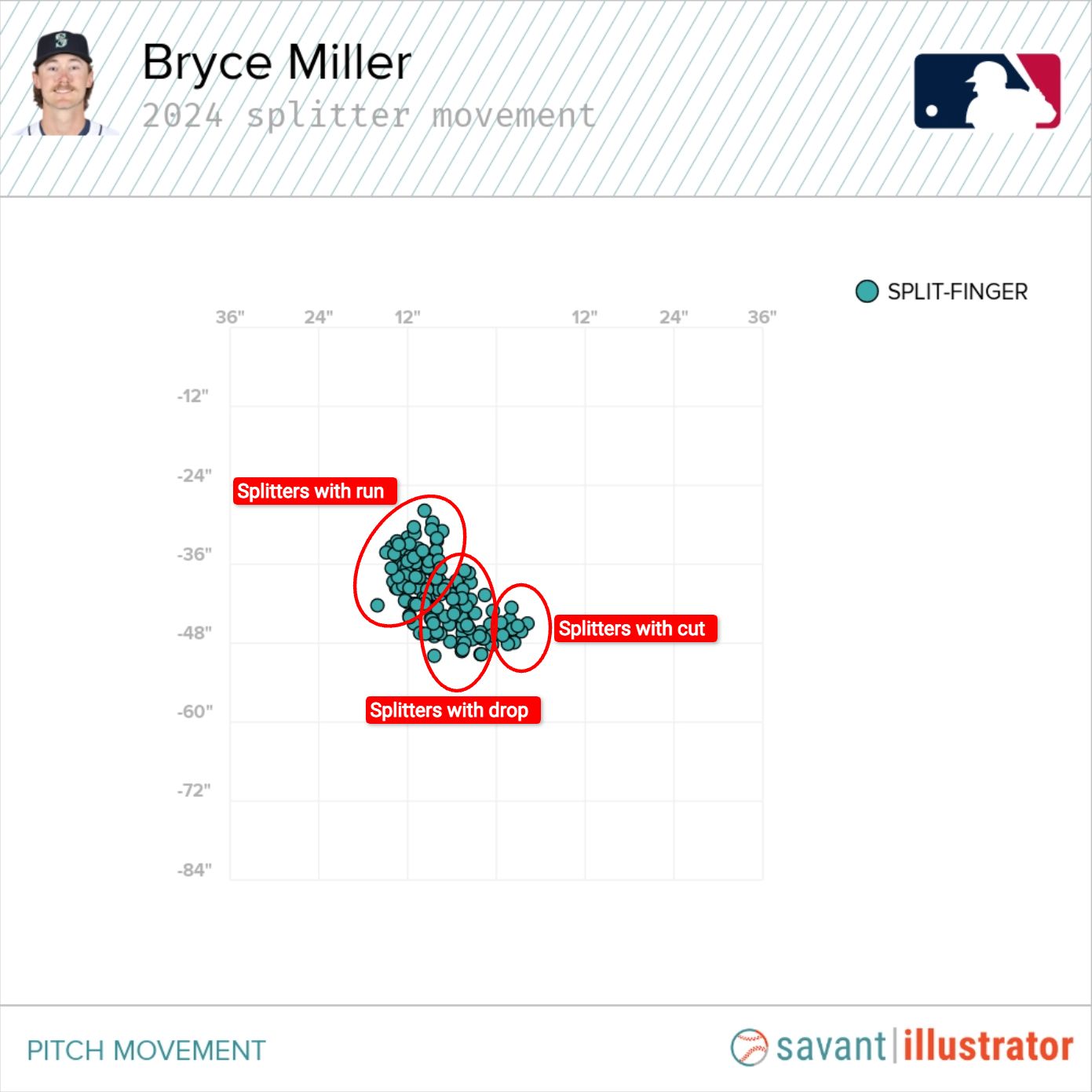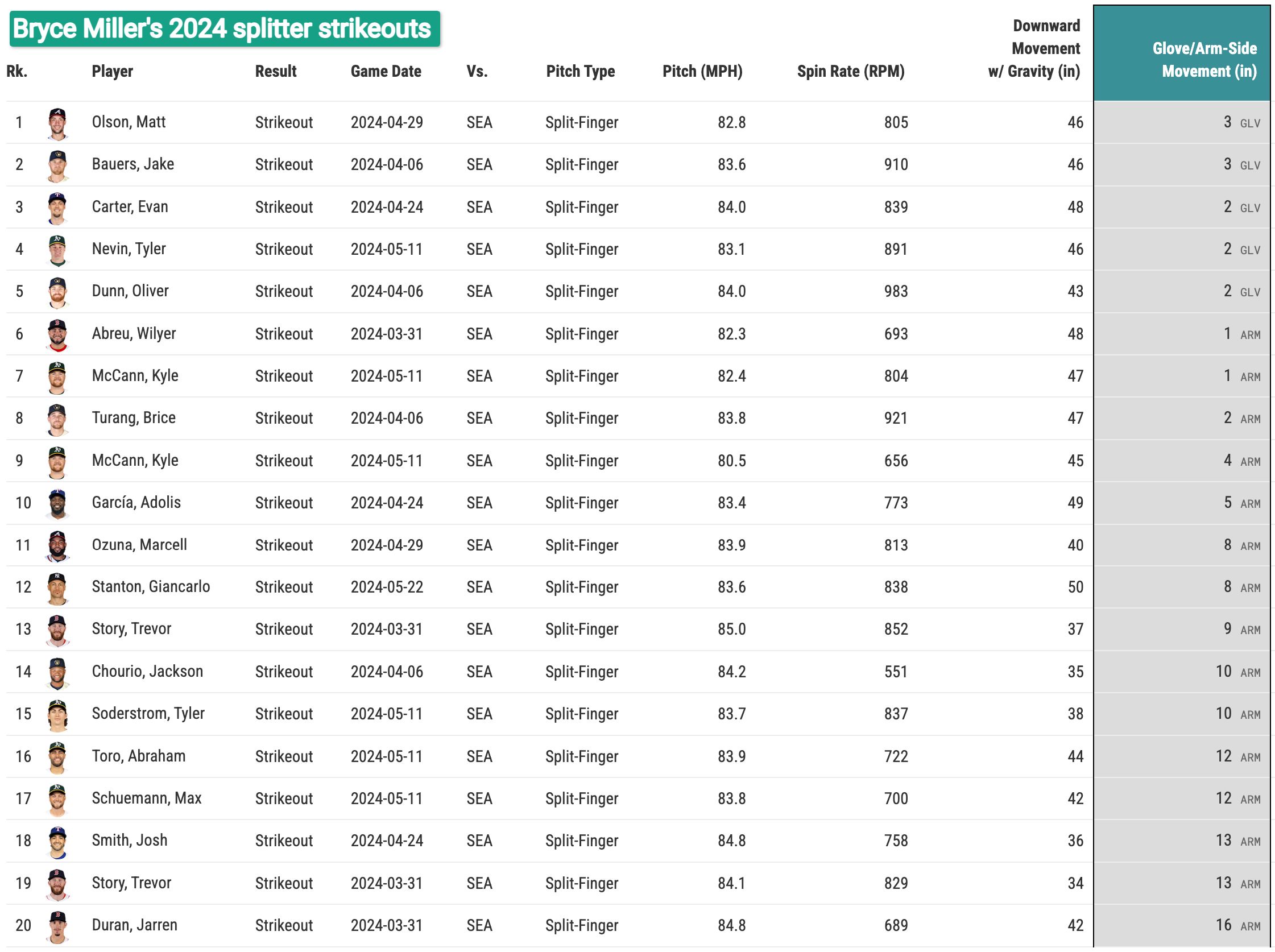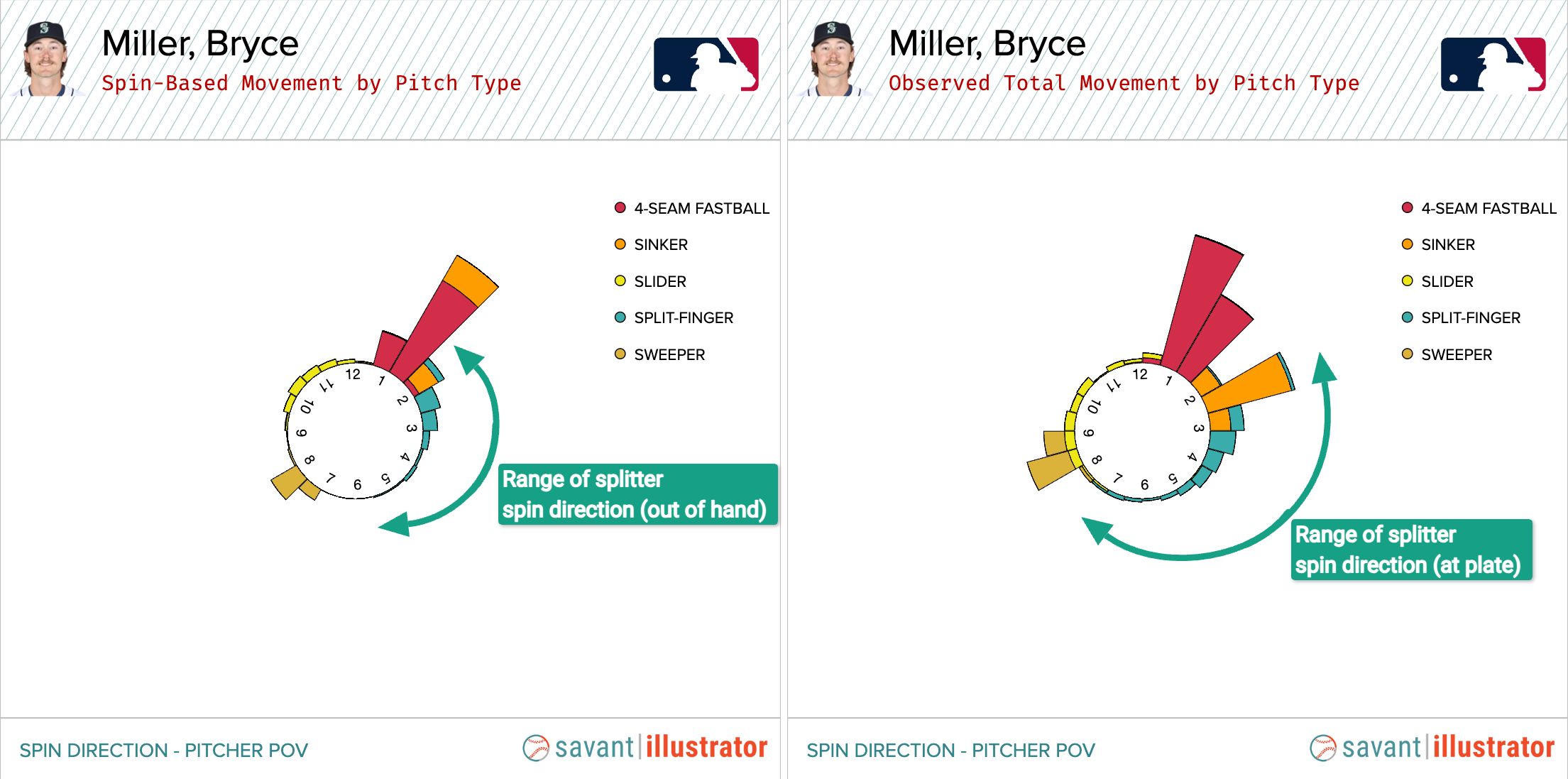Bryce Miller is one of the faces of MLB's splitter movement. But he doesn't just have a new splitter. He has three splitters in one.
With splitters on the rise in the Majors in 2024, the Mariners right-hander developed one himself over the offseason, joining his Seattle rotation-mates Logan Gilbert and George Kirby, who already threw the pitch. The trio makes the Mariners one of the most splitter-heavy pitching staffs in the big leagues.
But it turns out, Miller's version of the split-fingered fastball is rather unique. Why? The different ways it moves.

Miller's splitter has an incredibly wide range of movement. It can run as much as 16 inches. It can drop as much as 50 inches. And it can even cut as much as four inches.
"It just kind of does that on its own," Miller said with a laugh. "Sometimes it'll be really depth-y, and then sometimes it takes off. I don't know."
But that's actually what makes his splitter so good. Miller has shown three distinct movement patterns within the same pitch type -- the vertically dropping splitter, the arm-side fading splitter and the paradoxical cutting splitter -- and that makes his splitter a baffling pitch to hitters.
You can see that trio of splitter types within Miller's pitch movement chart. Here's that same plot as above, but isolating Miller's splitters, and the three movement profiles they take on:

By the results, Miller's splitter has been his most successful pitch this season, even though he just started throwing it this year. Opponents are batting just .154 and slugging .212 against it, both the lowest marks for any of the five pitches he throws, and he has 20 strikeouts on splitters, second only to his rising four-seam fastball, which has been his primary weapon since he broke into the big leagues last year.
The strikeouts are worth paying attention to. They show you that Miller's diverse splitter movement is not some problem of inconsistent delivery. It's actually what makes his splitter effective. He doesn't need to tighten up his pitch shapes.
Here's a look at two pairs of Miller's most extreme splitter K's using Statcast's 3D tracking technology. You can see how the same pitch, moving two exact opposite ways, would pose problems for a hitter deciding where he has to swing.
Miller's splitter strikeouts span a range of close to 20 inches, from one side of the plate to the other. He struck out the Red Sox's Jarren Duran on a splitter with over 16 inches of arm-side run on March 31; he struck out the Braves' Matt Olson on a splitter with over three inches of glove-side cut on April 29.
The day after he struck out Olson, Miller was talking to Braves reliever A.J. Minter, who relayed that the Atlanta slugger had been talking about the cutting, backdoor splitter that froze him.
"I don't know his exact words, but [Minter] told me Olson was saying, like, 'Yeah, what? Why did it do that?'" Miller said.
"I've got a couple of strikeouts like that this year, throwing it back-door to a lefty, and it accidentally kind of creeps back in."

There are just not a lot of pitches like Miller's splitter in the Major Leagues -- true strikeout weapons with such a diversity of movement.
In fact, only one pitch has produced strikeouts with a wider range of movement than Miller's splitter -- and it is MLB's only knuckleball, the one pitch that can truly flutter in any direction.
Widest range of break on K's of same pitch type, 2024
Min. 10 K's on the pitch type
- 1. Matt Waldron's knuckleball: 23 inches (7" of cut to 16" of run)
- 2-T. Bryce Miller's splitter: 19 inches (3" of cut to 16" of run)
- 2-T. JoJo Romero's slider: 19 inches (1" to 20" of break)
- 4. Freddy Peralta's slider: 18 inches (0" to 18" of break)
- 5-T. Brandon Pfaadt's sweeper: 17 inches (3" to 20" of break)
- 5-T. Kyle Hendricks' changeup: 17 inches (3" to 20" of run)
"When I get in finish counts, or get ahead in a count, I just want to throw it below the zone, and have it look like a strike for as long as possible," Miller said. "And if it's moving either direction, or just straight down, that's fine, as long as I'm locating it."
Miller's splitter is more similar to a knuckleball than you might realize. It's a very low-spin pitch, which gives it the tumbling action that makes it so hard to hit.
Miller is averaging just 828 rpm on his splitter, the seventh-lowest spin rate for any pitch type in the Majors in 2024. Waldron's knuckleball, of course, is the lowest, at 240 rpm.
"The different movement makes it harder to command, but I think with the lack of spin, it just kind of tumbles, and if they don't know that it's gonna come in on them, or if it's just gonna dive, that helps me," Miller said.
No matter how much it breaks horizontally, though, or in which direction, the hallmark of Miller's splitter is its depth, which is exactly what he wants. His splitter averages 40.5 inches of drop, which is almost five inches more than an average splitter, when comparing Miller to pitchers with similar velocity and release point. That puts Miller near the top of Statcast's splitter vertical movement leaderboard.
Splitter with most drop above avg., 2024
- 1. Matt Bowman: +4.8 inches
- 2-T. Bryce Miller: +4.7 inches
- 2-T. Tylor Megill: +4.7 inches
- 4. Jordan Hicks: +4.6 inches
- 5. Tanner Houck: +4.5 inches
"The main thing with it is, I don't want to throw it, like, in the middle, but my target is middle, and just have it finish below," Miller said. "And it's really the same for lefties and righties. I throw a lot of heaters up, and sinkers arm-side, so when I'm throwing that pitch, as long as it's below the zone, they're not going to really have much damage on it."
The Mariners' other splitter throwers, Gilbert and Kirby, are also in the top 10 for lowest spin rate. But even though they were throwing their splitters last season, before Miller designed his own, they're actually not who he drew inspiration from.
Instead, Miller watched a pair of splitter-wielding aces from other teams: the Mets' Kodai Senga, and the Blue Jays' Kevin Gausman.
"I was mainly using them -- because it was a new pitch, something I'd never thrown before -- just as a target," Miller said.
Senga's "ghost fork" forkball is at least somewhat similar to the splitter Miller is throwing now, a low-spin, lower-80s, tumbling offspeed pitch. Gausman's profiles a little differently, coming in firmer in the mid-80s with slightly higher spin, which Miller thinks gives it a more consistent shape than his variable splitter.
Miller realized that early in the development of his splitter over the offseason. The nastiness and style of Senga and Gausman's splitters were a basic blueprint, but he's not chasing their specific metrics.
And by now, Miller's splitter is his own, anyway.
His low spin rate might contribute to the way one splitter can move so distinctly from the next, but the main reason behind the difference between Miller's splitters is a difference in finger pressure -- specifically, which of his two split fingers stays on the baseball longer, his index finger or his middle finger.
When the ball is on his right index finger longer, he stays inside the pitch, his hand tilts inward, and he gets more sidespin, resulting in a splitter that runs side-to-side. When he stays through the baseball with his middle finger, he gets truer vertical drop … or even the rare cut if the ball is really coming off those outside fingers.

"It's not a pitch that I'm able to dot up with or anything, mainly because of the wide variety of shapes," Miller said. "But as long as it's depth-y, I think it plays well off of any of my other pitches, no matter which way it's going."
Statcast research & development manager Jason Bernard contributed research to this story.
